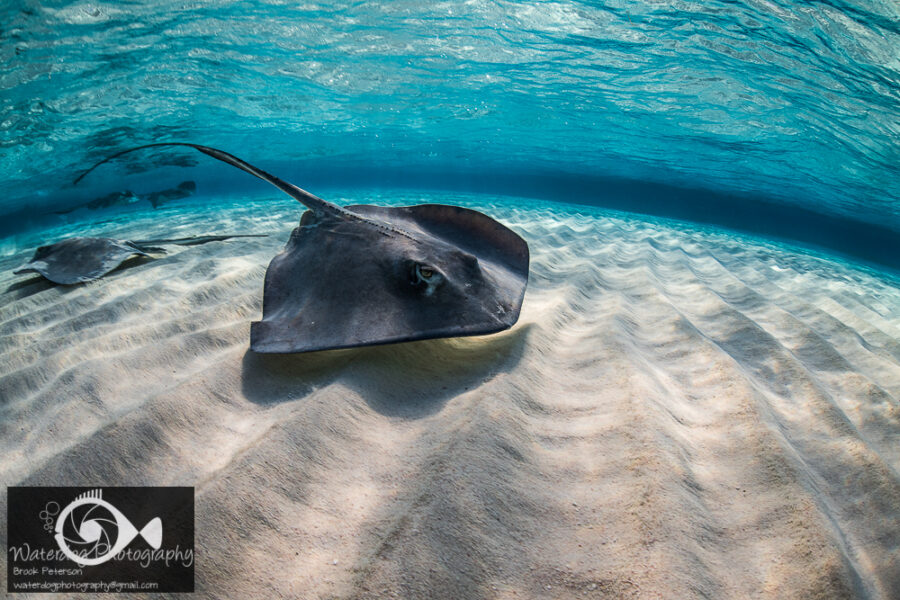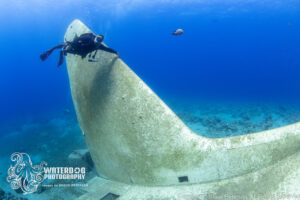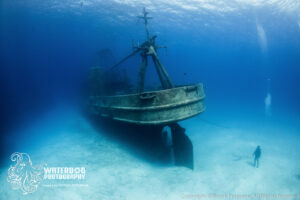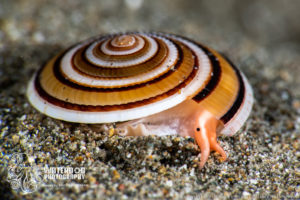
The image above was taken in about 30 feet (10 meters) of water. At this point much of the color has been lost. The scope of the image is too vast to be covered by strobes so only ambient light is being used. The sun is directly overhead which helps to light the hard corals and also gives dimension to them by creating shadows. The sharks in the image are close enough to the surface that the sunlight reflects off their backs as well as a bit of sunlight bouncing back from the corals to light up their white undersides. Understanding how the sunlight is working in this scene makes it possible to pull off a good image. Note: Some color can be restored using white balance adjustments in post processing.

The direction from which the sunlight is coming is very important. When the sunlight is coming from behind, the subject will have more detail and color. This is true whether or not strobes are used.

When the camera is pointed into the sun, the subject will be more dramatic with shadows instead of detail. This can be especially effective when converting an image to black and white as the exaggerated shadows and highlights add artistic drama to the image.

Silhouettes are also made by shooting toward the light. In the above image, all the colors have been absorbed by the water leaving only blues and blue-green. However, this works well for this image as it adds to the rather dark and mysterious ambiance of the diver exiting a cave.

In some cases it is appropriate to use red tinted filters such as Magic Filters to restore color in-camera. The shipwreck above is far too large to light with strobes. Without the use of filters, it would be difficult to retain the blue water in the background, when adjusting the white balance to achieve color in the ship. This is because when magenta and yellow are added in post-processing, blue is taken away. The result is a ship with color, but a washed out whitish or grayish background. Using filters, the color of the water will stay blue without any fall off of color, and the ship will have some color as well. In this image, the sunlight is coming from behind adding to the detail and color of the ship.

Filters can also be used to restore color as seen naturally by the diver. The framework shown above is the remains of a shipping container now covered with soft coral. The filter restores color to the corals and renders the sand the correct color throughout the image. In other words, the corals toward the front of the frame have just as much color as the corals at the back of the frame. Without strobes or a filter, the entire image would appear blue-green. The sun is again coming from behind and slightly from the left adding to the color and detail of the image.

This is the same shipping container with strobes as the light source. The light from the strobes begins to fall off around the edges of the frame leaving them slightly green with the corals in the middle receiving most of the light. They are therefore the most colorful. While both images are acceptable, they clearly demonstrate how different the results are when using strobes and using filters. Note: Filters work best at a depth of 30 to 50 feet (10-18 meters). They cannot restore color if there is no color to restore, and water absorbs most of the color beyond this depth.

In water less than a meter or two deep, it is usually preferable to use only the sun as your source of light. There is only a little loss of color at this depth and dramatic results are often achieved with the sunlight. In this image of a sting ray, the sun is almost directly above and the waves on the surface create shadowy patterns on the sand that are pleasing.
While underwater photographers most definitely need strobes for the majority of the time, ambient light can be used creatively in a number of situations. Understanding how sunlight affects the environment is an important part of using it as an advantage.
Join me for a workshop! Travel to a great destination where you will have exclusive coaching on your underwater photography. Meet new people, network, try new techniques, and learn with the pros! Click on Travel and Workshops for more information!






